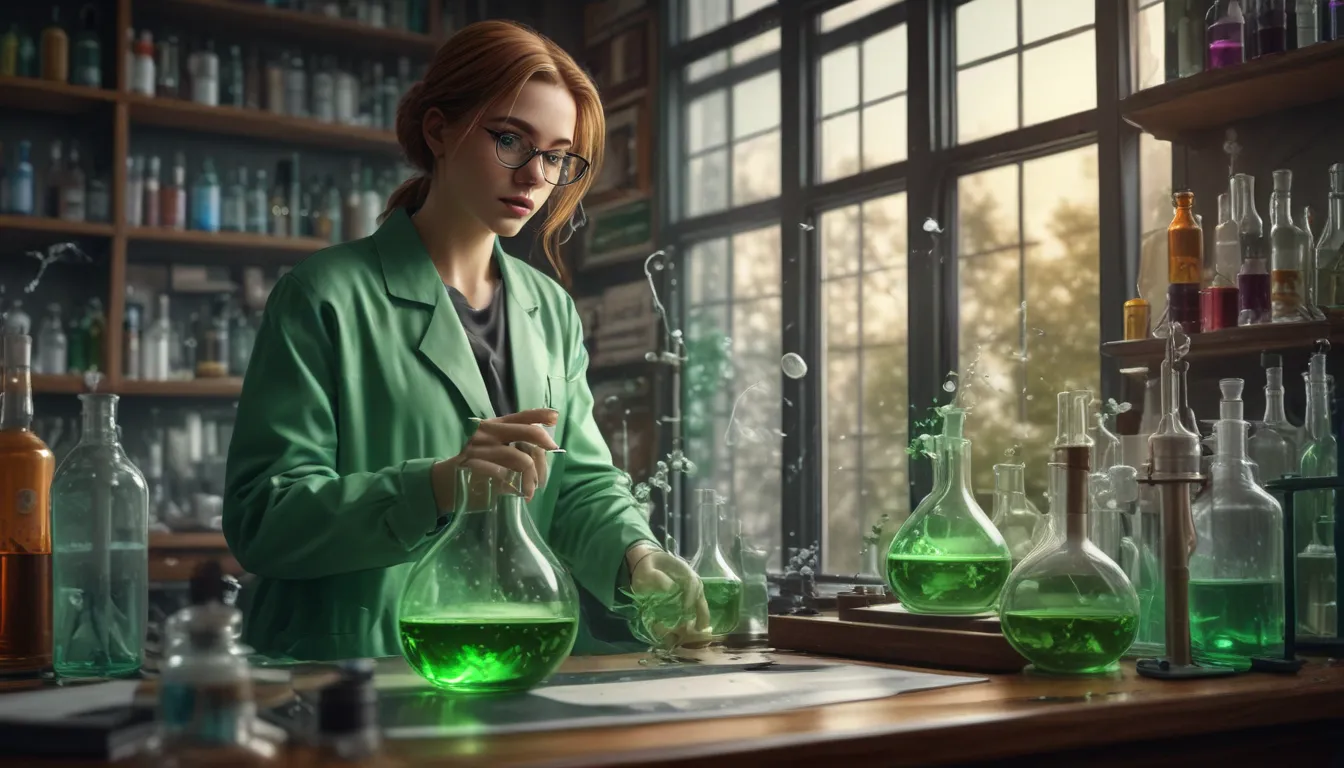A Note About Images: The images used in our articles are for illustration purposes only and may not exactly match the content. They are meant to engage readers, but the text should be relied upon for accurate information.
As the world grapples with the pressing need for sustainable solutions, the field of green chemistry emerges as a beacon of hope. Pioneering the way towards environmentally friendly practices, green chemistry aims to revolutionize the world of chemistry by fostering innovation, sustainability, and efficiency. In this article, we embark on a journey through 11 captivating facts about green chemistry, shedding light on its origins, impact, and potential to shape a greener future for all.
Unveiling the Origins of Green Chemistry
Green Chemistry, also known as sustainable chemistry, rose to prominence in the 1990s in response to escalating concerns over pollution and the detrimental effects of traditional chemical practices on human health and the environment. This pioneering field focuses on developing chemical processes and products that prioritize environmental friendliness, setting the stage for a paradigm shift towards a more sustainable future.
Reducing Harmful Waste: A Core Tenet of Green Chemistry
At the heart of green chemistry lies a steadfast commitment to waste reduction. By minimizing or eliminating the generation of hazardous substances during chemical production, green chemistry not only safeguards ecosystems and human health but also alleviates the financial burdens associated with waste disposal. This ethos underscores the transformative potential of green chemistry in driving sustainable practices across industries.
Embracing the Significance of Renewable Resources
Green Chemistry champions the utilization of renewable resources as sustainable alternatives to non-renewable fossil fuels. By harnessing renewable feedstocks such as biomass, we can mitigate our reliance on finite resources and diminish the carbon footprint of chemical processes. This eco-conscious approach underscores the pivotal role of renewable resources in fostering a more sustainable and resilient future.
Cultivating Innovation through Solvent Selection
Innovative solvent selection stands as a cornerstone of Green Chemistry, advocating for the adoption of safer and more sustainable solvents. By replacing traditional solvents with greener alternatives such as water or bio-based solvents, we can minimize environmental impacts while upholding the efficacy of chemical reactions. This strategic shift towards sustainable solvents epitomizes the transformative power of green chemistry in driving eco-friendly practices.
Catalysis: Catalyzing Efficiency in Green Chemistry
Catalysis plays a pivotal role in Green Chemistry by facilitating the efficient conversion of raw materials into desired products. Through the use of catalysts, chemical reactions can occur at lower temperatures, requiring less energy and yielding fewer byproducts. This emphasis on catalysis underscores the potential of green chemistry to enhance energy efficiency and reduce environmental impacts in chemical processes.
Embracing Bio-based Materials for a Sustainable Future
Green Chemistry advocates for the development of bio-based materials derived from renewable sources such as plants and biomass. These sustainable alternatives offer a viable substitute for petrochemical-based products, diminishing reliance on fossil fuels and mitigating environmental harm. By championing bio-based materials, green chemistry paves the way for a more sustainable and resource-efficient future.
Proactive Pollution Prevention
Green Chemistry takes a proactive stance on pollution prevention by designing chemical processes that minimize waste and emissions of toxic substances. Through strategic planning and innovation, green chemistry endeavors to significantly reduce pollution, fostering cleaner air, water, and soil. This commitment to pollution prevention underscores the transformative potential of green chemistry in safeguarding environmental and human health.
Embracing Life Cycle Assessment in Green Chemistry
Life Cycle Assessment (LCA) serves as a critical tool in Green Chemistry for evaluating the environmental impacts of products and processes throughout their life cycles. By considering factors such as raw material extraction, production, use, and disposal, LCA enables informed decision-making and fosters sustainability practices. This holistic approach to sustainability underscores the importance of integrating life cycle assessment in green chemistry initiatives.
Empowering Education and Awareness in Green Chemistry
Green Chemistry advocates for education and awareness of sustainable practices within the chemical industry. By incorporating sustainability principles into chemistry curricula and raising awareness among professionals, green chemistry aims to accelerate the adoption of eco-friendly practices. This focus on education and awareness underscores the pivotal role of knowledge dissemination in driving sustainability across industries.
Government Regulations: Fostering a Culture of Sustainability
Governments worldwide are increasingly recognizing the importance of green chemistry in addressing environmental and health challenges. Regulatory frameworks and incentives are being developed to promote the adoption of green chemistry practices, fostering innovation and sustainability. This collaborative effort between governments and industry stakeholders underscores the collective commitment to driving sustainability and environmental stewardship.
A Global Endeavor towards Sustainability
Green Chemistry epitomizes a global movement, uniting scientists, industry professionals, and policymakers in a collective pursuit of sustainable practices. Through collaborative efforts and knowledge sharing, green chemistry serves as a catalyst for creating a more sustainable future. This global endeavor underscores the transformative potential of green chemistry in shaping a greener, more resilient world for generations to come.
In Conclusion: Paving the Way for a Sustainable Future
In the realm of green chemistry, the promise of sustainable and environmentally friendly solutions unfolds with each innovative breakthrough. By prioritizing waste reduction, resource conservation, and environmental stewardship, green chemistry offers a pathway to a more sustainable and healthier future. From pharmaceuticals to materials science, green chemistry stands poised to revolutionize industries and propel us towards a greener tomorrow.
Unveiling the transformative potential of green chemistry, we witness a paradigm shift towards sustainability and innovation. By embracing green chemistry principles, we pave the way for a greener and more sustainable future, where environmental stewardship and economic viability converge harmoniously.
FAQs: Exploring Green Chemistry
-
What is green chemistry?
Green chemistry is a scientific approach that focuses on developing environmentally friendly, sustainable, and economically viable chemical processes and products. It aims to minimize the use and generation of hazardous substances, safeguarding human health and the environment. -
Why is green chemistry important?
Green chemistry is essential as it offers a sustainable and eco-friendly alternative to traditional chemical practices. By reducing waste, conserving resources, and minimizing the use of harmful chemicals, green chemistry fosters environmental protection and human well-being. -
How does green chemistry benefit society?
Green chemistry benefits society by promoting the development of safer and more sustainable products, reducing pollution and waste, conserving resources, and enhancing resource efficiency. It contributes to a healthier and more sustainable future for all. -
What are some examples of green chemistry applications?
Green chemistry finds applications in various fields, including renewable energy, eco-friendly pesticides, biodegradable packaging materials, and sustainable pharmaceutical production. These applications showcase the versatility and potential of green chemistry in driving sustainable innovation. -
How can individuals contribute to green chemistry?
Individuals can contribute to green chemistry by making conscious choices in their daily lives, supporting environmentally friendly products, recycling hazardous materials, advocating for sustainability initiatives, and championing the adoption of green chemistry principles in diverse industries. By fostering a culture of environmental stewardship, individuals play a crucial role in advancing green chemistry initiatives.
The transformative impact of green chemistry extends far beyond its compelling facts. Embrace the journey towards sustainability and innovation as we explore the catalytic role of green chemistry in shaping a greener and brighter future for all.
Our unwavering commitment to delivering accurate and engaging content underscores our dedication to providing valuable insights and knowledge. Each fact shared on our platform is a testament to our community’s diverse perspectives and collaborative spirit. Trust in our pursuit of authenticity and excellence as we embark on a collective journey of exploration and discovery.





